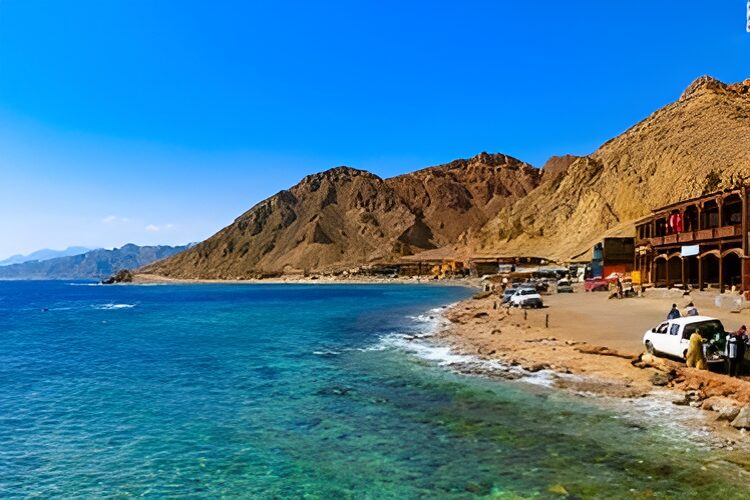Excursions
Cairo Sites
Cairo is the capital of today’s Islamic world and the largest city in Africa. Its population is about 16 million, which makes it one of the world’s most populist cities. In Cairo, you will encounter the world’s most ancient civilization, the only remaining monuments of the world's Seven Wonders, and priceless treasures that can be admired in its museums. Remnants of the past can be found in the old quarters and the picturesque markets, from which perfumed scents of the East are both mysterious and attractive. The imposing mosque and superb churches that are less ancient mark another stage in civilization and art. Modern Cairo is very striking because of its large open squares, its admirable Corniche, modern buildings, and luxurious hotels. It is a charming city, rich in scenes of great variety. Cairo is unique in its ability of ancient traditions to mingle with modern lifestyles, which forms the contemporary Egyptian culture.
The Pyramids of Giza are world-famous due to their magnificence and beauty. All of this dwindles when compared to the precision and astounding ability of the ancient Egyptians in building the Pyramids, which can not be replicated with all of our modern technology nowadays.
King Cheops (Khufu) built the Great Pyramid in 2560 BC, its height now being 137 meters (originally 146 meters) and its base about 230 meters wide. The Pyramid builders used about 2.5 million blocks of limestone. It is believed to have been built over a 20-year period.
The Second Pyramid was built by King Kephren (Khafra) to the southwest of his father’s (Cheops) Pyramid. It is 136 meters high, with a base of about 215 meters. This Pyramid still retains portions of the limestone that once covered the entire Pyramid.
The Third Pyramid was built by King Mycerinus (Menkaure) to the southwest of the Second Pyramid. Being a lot smaller than the two other Pyramids, it is only 62 meters high. The lower parts of this pyramid still retain some granite portions on its lower part, which is lacking in the other two Pyramids.
The Sphinx, the guardian of the Giza Plateau, is one of the most well-known monuments in Egypt. Its fame has spread to all the world as the symbol of silence and intrigue. This legendary statue has the body of a lion and the face of a man, which makes it quite a mysterious monument. It is believed that it represents the god Horus in the Horizon. It is 70 meters long and 20 meters high. Scholars and scientists believe that the face of the Sphinx closely resembles that of King Kephren, the builder of the 2nd pyramid.
Saqqara, the City of the Dead, is the oldest ancient Egyptian cemetery. It lies in a desert plateau, southwest of Cairo in the city of Memphis, the capital of Egypt during the Old Kingdom. Saqqara is filled with tombs that lie beneath all the heaped mounds. In Saqqara and Dahsure we will find various Pyramids that will show us how each of them played a role in building the Great Pyramids of Giza. For example, the Bent Pyramid and Red Pyramid.
The Step Pyramid is the first freestanding stone building in history. It was designed by the great architect Imhotep for King Zoser. He wanted to build for his king a unique tomb, something that had never been erected before. The first project of one flat rectangular structure was changed to one of six steps, one on top of the other, from whence it bears the name of the Step Pyramid.
The Red Pyramid is one of the unique pyramids in Egypt. It was the first successful attempt to build a smooth surface pyramid by King Snefru. King Snefru had two prior attempts with the Bent Pyramid and the Meidum Pyramid, but unfortunately, both of them failed. It is called the Red Pyramid due to the reddish/pinkish limestone used in its casing. It is also called the Northern or Shining Pyramid. All three chambers in this pyramid have stepped ceilings. The ceiling's design is so strong that even today, there are no cracks or structural problems even with some two million tones of stone above it. The first two chambers are at ground level, while a third chamber is higher. It is built within the masonry of the pyramid itself.
The Egyptian Museum is home to the most extensive collection of ancient Egyptian artifacts. It contains over 138,000 items on display and hundreds of thousands in its basement storage rooms. It was built in 1900 in a neo-classical style by the French architect Marcel Dourgnon. Some of the museum’s highlights are King Tutankhamun’s artifacts, mummies of ancient Kings and Queens, statuses, jewelry, and many other superb priceless treasures from all over Egypt.
The Citadel & Mohammad Ali’s Mosque
Built by Saladin in 1176 to protect Egypt from the Crusaders, the Citadel was the strategic stronghold of Cairo for 700 years. Overlooking the city it was easy to defend from any attacks. It was designed as a fortress, much inspired by the fortresses of Syria and Palestine, used by the armies during the Crusades. Later Mameluke sultans and Turkish governors made it their residence.
The Citadel is actually made up of several buildings. One of the most famous buildings in this compound is the famous Mosque of Muhammad Ali.
Mohammad Ali's Mosque is one of the most famous mosques in Egypt. It is distinguished by its beautiful architectural design, numerous domes, and tall minarets. The architects modeled it after the Blue Mosque in Istanbul. Due to the extensive use of alabaster stone throughout, it is also called the “Alabaster Mosque.” The mosque is a masterpiece and an excellent example of Islamic art. The roof is decorated with five domes and five half domes. The mosque is rectangular and divided into two sections: the Eastern Section, the main section in which the prayers and sermons are held and the Western Section, an open courtyard.
Old Cairo is the oldest part of Cairo. It is truly a multi-faith area where Jewish, Coptic, and Islamic monuments all stand next to each other. The area dates back to 640 A.D. with churches and cathedrals having been built in the 7th century. Some of the most interesting sites to visit are the Hanging Church, the Coptic Museum, Mohammad Ali’s Mosque, the Ben Ezra synagogue, and the Abu Serga Church, in which the Holy Family spent much of their time when they were in Egypt.
The ancient Egyptians carved spacious areas in the rock near the Pyramids. There they placed wooden boats to be at the disposal of the king when he went on his journey of Day and Night with the sun god, Ra, in the after world. It is thought that these boats have been used to carry the body of King Cheops on his last journey on earth before being buried inside the pyramid. Early excavations have discovered three such sun boat sites on the east side of the Great Pyramid. Other sites were discovered on the south side. When the huge stone slabs were removed, they revealed parts of a large boat, made of cedar wood, that are in excellent condition. These boats can be seen in a special museum, south of the Pyramid of Cheops.
The Sound & Light show at Giza captures its audience’s awe with the beauty of the Pyramids and the Sphinx when they are lit at night. It allows the audience to relive ancient times by hearing stories of Ancient Egypt, the glorious Pharaohs and Kings, how the Pyramids were built, and their guardian, the Sphinx. The show is enhanced with sound, light, music, and laser lighting. This 45-minute show occurs at the base of the Giza Pyramids.
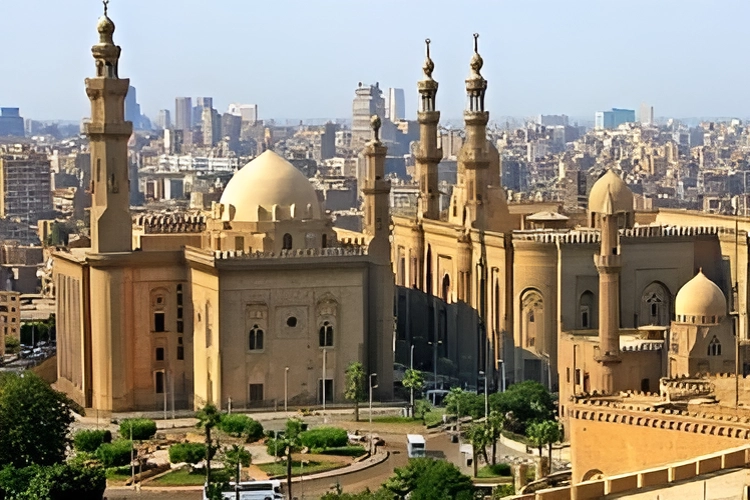
Alexandria Sites
Alexandria was named after its founder Alexander the Great, who established the town in 331 B.C. Since its inauguration, Alexandria always enjoyed a privileged place in history and continued to develop throughout the ages. Today it is a vital commercial center lying at the cross roads of the main trading routes between Asia, Africa and Europe. It is renowned for its long stretches of white sandy beaches which extend for more than twenty miles and which have given the town its name "The Pearl of the Mediterranean." Favored with an unequaled climate, extremely mild in winter, moderate and refreshing in summer, Alexandria attracts holiday seekers and is today the most popular summer resort in Egypt.
The museum which was founded in 1892 houses about 40,000 artifacts that date back from 200 B.C. to 700 A.D. Most of the artifacts are very special pieces mixing Pharaonic and Greco-Roman arts. It has a fascinating record of civilization in the process of change as religions combined and society evolved. The unique collections of this museum belong to many cultures like the Ancient Egyptian, Hellenistic, Greek, and Romans.
Catacombs are underground tombs dating back to the 1st century A.D. They were used by the Ptolemaists, the Greeks, and other foreigners. The uniqueness of these tombs can be found in their design plan and their decoration which are a mixture of Egyptian and Greco-Roman arts. It was discovered in the 1900s when a donkey cart fell in its pit. It consists of three stories in the rock. The Catacombs are called so because their design is similar to the Roman Christian Catacombs. The entrance leads to a spiral staircase of 99 steps that goes around a shaft, which was used to lower the body of the deceased by ropes to prevent any damage. The sarcophaguses and their lid are cut from a single block. The body of the deceased was placed into the sarcophagus through an opening in the back wall, which was blocked after burying the body.
Montaza Palace is indeed a glittering pearl. It used to be the summer residence of Egypt's former royal family. Built on an elevation that overlooks Alexandria's beautiful beaches, it stands amidst woods of elegant evergreens. The first floor has been converted into an international casino. The second and third floors are now a museum that displays the private belongings of the former royal family.
Pompey's pillar was erected by Posthumous around 292 A.D. in honor of Emperor Diocletian as a part of a huge temple. It was named by the Crusaders in the Middle Ages because they believed that the aches of the Roman general Pompey were put in a pot on the top of the pillar. The pillar is made of beautiful red granite and is about 26 meters high.
The Citadel of Qaitbay was constructed in the 15th century during the reign of Sultan Ashraf Qaitbay. It is located on the Mediterranean Sea coast, where the famous Pharos Lighthouse (one of the world's Seven Wonders) used to stand. The citadel was built to defend Egypt from the Ottomans, whose power was increasing in the Mediterranean. It continued to function during most of the reign of the Mameluks and the Ottomans. After the British bombardment of Alexandria in 1883, it was neglected until the 20th century, when it was restored by the Egyptian Supreme Counsel of Antiquities.
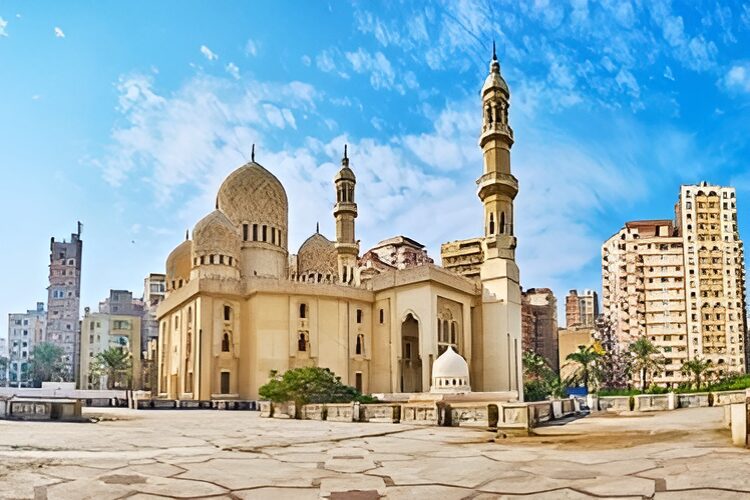
Luxor Sites
Luxor was called 'the city of a hundred gates' due to its buildings and large gates. Arabs were impressed by its beautiful palaces and re-named it Luxor (City of Palaces.) Two thirds of the world’s monuments are in Luxor which makes it a very remarkable place that must be seen. It offers its visitors with a large number of amazingly huge temples and colorful tombs which astonishes every single visitor. It is divided into two sections by the Nile River. The east side is called the Site of Living where ancients Egyptians used to live out their daily lives, and the west side is called the City of the Dead where we will find all the tombs and burial site of the dead
The temple area is a vast open-air museum and the largest ancient religious site in the world. It is a group of temples surrounded by one enclosure wall that is dedicated to the god Amon-Ra, his wife Mut, and their son Khonso. The temple covers an area of about 60 acres. In Ancient Egypt, the temple was called "The House of Amon" or "The Most Sacred of Places." The key difference between Karnak and most of the other temples is the length of time over which it was built. Approximately 30 pharaohs contributed to the buildings. In addition to the main sanctuary, there are several smaller temples and a vast sacred lake, which was used for purification.
Luxor temple was one of the most important cult temples in Ancient Egypt. Amenhotep III decided to build a whole temple for the god Amon. Later Ramses II added a new open court, a massive façade representing its entrance, a huge pylon, and two seated statues of the king. The name of the temple in ancient Egyptian was "The House of Amon in the southern holy of hollies," or "The Southern Harem." Originally, two large obelisks stood in front of the pylon. However, now only one remains, while the other one stands in Place de la Concorde, Paris.
Beginning with the 18th dynasty, royal burials were completed underground to safeguard the mummies and rich furnishings from grave robbers. These tombs were carved out of the rocky cliffs located in this valley within the cemetery of Luxor, the capital of Egypt during the New Kingdom period. So far 63 tombs have been discovered. Some of these tombs are of great kings like Ramsses I, II, III, VI, Seti I, Thumosis III, and Mernptah. The most famous tomb is that of King Tutankhamen, which was discovered in 1922. Its discovery captured worldwide attention because of all the treasures that it contained.
The Valley of the Queens is situated at the south-west end of the Theban necropolis. It contains about 100 tombs of the queens and young princes of the 19th and 20th Dynasties. Among the most interesting is the tomb of Queen Nefertari, whose walls are covered with vividly colored scenes, and that of prince Amon-Hor-Khopshef son of Ramsses III.
Queen Hatshepsut's temple is also known as El Deir El-Bahari because a Christian Monastery once existed there. It was built by the architect Sennmut, who was a very high official in the court of Queen Hatshepsut. She wanted to honor her father (god Amun) by building him a very beautiful temple. She asked her architect not to spare any effort in making this temple the best of its kind. The temple was built according to the Queen's orders, and an extensive garden was planted in front of its terraces. Many trees were brought by a special expedition from Punt (currently Somalia). On the walls of the temple are images showing various religious and social scenes, some of which still retain their splendid original colors. The majority of the figures of Queen Hatshepsut have been fiercely mutilated, together with her name, as a vengeance by her half-brother Thutmosis III, whom she successfully supplanted for many years.
The temple of Abydos dates back to the New Kingdom. Seti I founded the great temple in honor of the ancestral kings of earlier dynasties and it was finished by Ramses II. It is built of fine textured limestone and has many unique features such as the Osirion building as well as lots of amazing colors which are still on its walls today. The Osirion displays offering scenes and many other scenes from the Book of the Dead. As one of the tombs of a 1st dynasty King thought to be that of Osiris, the temple became a great pilgrimage center in ancient times. In a famous myth, Osiris, the god of fertility was killed by his brother Set who cut Osiris' body into 14 pieces and spread it throughout Egypt. Isis, Osiris’ sister and wife found his scattered body parts and brought him back to life. Horus, Osiris’ son later killed his uncle Set and became the new king of Egypt. Due to Osiris’ cult, Abydos also became the most famous cult center in Egypt.
In ancient times Dendera meant “she (Hathor) the pillar’s goddess,” and to her, the temple is dedicated. She was considered the mother of the gods, the celestial cow who brought them into the world, and the lady of joy, beauty, and love. On one of the chapel’s ceilings, there are amazing astronomical scenes of Goddess Nut, the goddess of the sky. She arches her body over Earth and the sun disc, shining on the temple and the mask of Hathor. In another chapel, we will find a perfect representation of the zodiac signs and scenes of Osiris rising from the dead and becoming the god of the underworld. One of the most interesting scenes is that of Horus and Thoth pouring drops of holy water over the King. This scene is called the baptism scene, which symbolizes life and happiness. It also houses a famous painting of Queen Cleopatra and Caesaron, her son of Julius Caesar. The temple is renowned for its horoscope inscriptions.
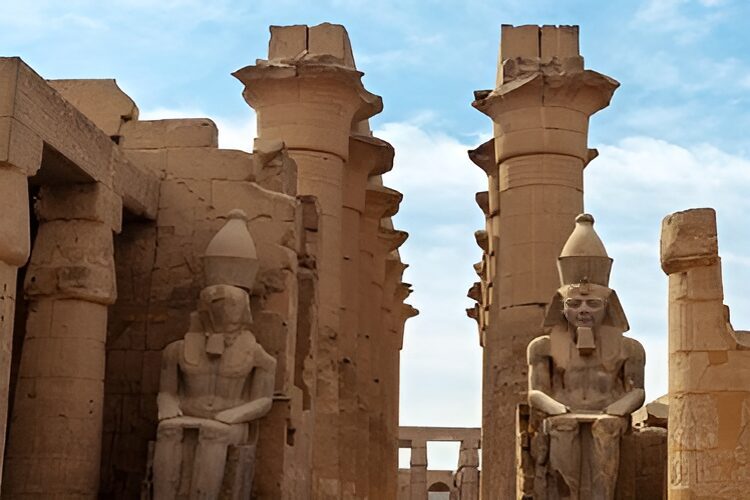
Aswan Sites
Aswan is known as the site of the Cataracts and has an extensive history. Now with the completion of the High Dam, Aswan continues to be in the highlights and adds one more tail piece to its destiny. From the very beginning, it was the gateway to the south and the natural route along which trade passed from the heart of Africa to Egypt. The ancient Egyptians named it Swnw (the market) because of its commercial importance and the main source of the fine and coarse quality granite from which builders and sculptors drew their supplies. Thanks to its dry climate and unique situation, Aswan has justly acquired an international reputation. For those who love calm and repose, no better place can be found! Here the Nile flows through granite rocks and the golden desert while palm trees and farm lands cover the banks.
Edfu is one of the most completely preserved temples, and it is the largest temple after Karnack. The divine marriage of Hathor and Horus is depicted on the walls of this temple, and it was celebrated twice a year, once at Dendera and the other time at Edfu. The walls of the mamisi (house of the divine birth) are decorated with scenes showing the story of the divine birth of Horus the child. The story of the divine birth is similar to that of baby Jesus. Edfu is spiritually connected with Hathor’s Temple at Dendera. During summer’s third month, the priests in the temple of Dendera place Hathor’s statue on her barque and bring it to Edfu, where it was believed that Horus and Hathor shared a matrimonial visit. Edfu temple is believed to be the site where the great mythological battle between Horus and his uncle Seth took place, in which Seth was defeated.
Kom Ombo, the hill of gold, is the only temple in Egypt that is dedicated to two gods, the god Horus and the god Sobek. This temple was originally built to worship the god Horus, but after the increase in the number of crocodiles on the island, the temple was demolished and reconstructed so that the people could worship god Sobek (the crocodile shaped god) for protection from the crocodiles. An imaginary line divides the temple longitudinally into two parts, each with its own entrance, hypostyle halls, and chapels. The right part of the temple was dedicated to Sobek, and the left to Horus. At this site we will find a Nilometer that was used to measure the level of the Nile. We will also find a series of surgeon's instruments that includes scissors, dilators, scalpels, and forceps. Mummified crocodiles and astronomical images can also be found in the temple. The temple includes a damaged pylon, a mammisi, a chapel for Hathor, an inner and outer hypostyle hall, and two sanctuaries.
Philae is considered to be a very beautiful and magnificent temple in the Nile Valley. It is dedicated to the goddess Isis and the god Osiris. The temple became submerged in the Nile after the first Aswan dam was built in 1906. During the 1970s, with the help of UNESCO, the Philae temple was completely moved from Philae Island to its new location on Agilika Island.
The main temple was converted to a church during the reign of Emperor Justinian and even now, crosses are visible throughout the temple. The temple has scenes depicting the birth of the god Horus by his mother Isis, which is similar to the birth story of baby Jesus. The temple is built in the same style as the temples of the New Kingdom, as well as some other elements, that appeared in the Greco-Roman period, such as the Mamisi (the House of the divine birth), and a Nilometer. In addition to the main Temple of Isis, there are other monuments here such as the Kiosk of Trajan and the Chapel of Osiris.
The Unfinished Obelisk lies in its original location in a granite quarry in Aswan. It is about 42 meters in length and was most probably abandoned when some cracks appeared in the rock during its construction. Had this obelisk been completed, it would have been the largest obelisk ever cut in Ancient Egypt, weighing nearly 1100 tons. It is believed that it was constructed and abandoned during the reign of Queen Hatshepsut. This obelisk is important because it shows the techniques adopted by the Ancient Egyptians in cutting out their obelisks.
Abu Simbel is among the most magnificent monuments in the world. The temples were threatened by submersion in Lake Nasser after the Aswan High Dam was constructed. With UNESCO’s help, the two temples were cut into large blocks and moved to a higher location.
The larger temple is for King Ramses II. The temple’s facade has four colossal statues of the King and is topped with 22 baboons whose arms are raised in the air to worship the rising sun. Ancient Egyptian architects positioned the temple in such a way that the sun’s rays penetrated the sanctuary on October 21 and February 21. These dates are believed to be the king's birthday and coronation date, respectively.
The smaller temple was the first temple ever dedicated to a queen. It is dedicated to the goddess Hathor and Nefertari, Ramses’ most beloved wife. It commemorates Ramses’ victory in the Battle of Kadesh, intimidates his Nubian neighbors, and honors his most beloved wife. The facade is decorated by six colossi, four of Ramses II and two of Nefertari, which are separated by a large gateway.
The High Dam of Aswan is one of the most important projects ever accomplished in modern Egypt. It saved Egypt from being destroyed by the flood of the Nile River and provided Egypt with water and electricity. The work began in 1960 and was completed in 1971. It measures 111 meters in height, 3,600 meters in length, and 1 kilometer in width. As a result of its construction, Lake Nasser was formed between Egypt and Sudan. It is considered to be the largest man-made lake. Because of raising the water behind the dam, a lot of Nubian monuments have been damaged or sunk. With UNESCO’s help, Egypt was able to save some monuments from being destroyed.
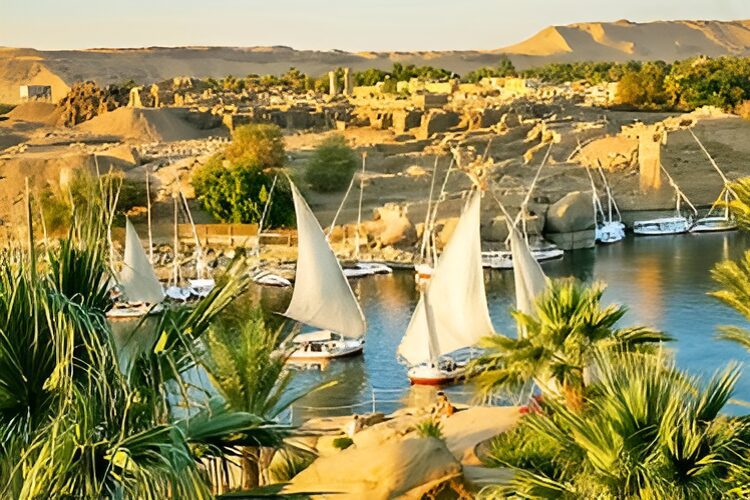
Red Sea Sites
Aswan is known as the site of the Cataracts and has an extensive history. Now with the completion of the High Dam, Aswan continues to be in the highlights and adds one more tail piece to its destiny. From the very beginning, it was the gateway to the south and the natural route along which trade passed from the heart of Africa to Egypt. The ancient Egyptians named it Swnw (the market) because of its commercial importance and the main source of the fine and coarse quality granite from which builders and sculptors drew their supplies. Thanks to its dry climate and unique situation, Aswan has justly acquired an international reputation. For those who love calm and repose, no better place can be found! Here the Nile flows through granite rocks and the golden desert while palm trees and farm lands cover the banks.
The beaches of the Red Sea are an exquisite gift of nature. The sea, with its clear blue waters, offers amazing brightness and vividly colored coral reefs and fish. The long chain of mountains, with their different colors, runs parallel to the coastline. All these elements along with wonderful winter and summer climates blend into a rare painting of magnificence of natural beauty that charms the visitor into believing he or she is on a legendary tour of a paradise on Earth. All that you may wish to see in a resort town and all the amenities to make your stay comfortable and convenient are right here. The Red Sea offers some of the best diving sites in the world. It is also blessed with a unique landscape, the golden desert, and tropical seas.
Diving, snorkeling, or swimming in the turquoise sea are some of the wide variety of activities to be enjoyed. When you're not relaxing on the golden beaches, you can climb mountains or drive into the desert.
The most preferred resort towns are:
Dahab
Marsa Alam
Sharm el Sheik
Hurghada
Sinai is a peninsula in which the true charms and magic of nature can be found. Moreover, it is a fabulous antiquity and the scriptural stories associated with it add awe and veneration to its pure beauty.
It is named the “Land of Turquoise” as ancient kings acquired their gold, copper, and turquoise. Legend has it that the prophet Abraham was stopped there by the Pharaoh’s soldiers, who sent him to the king. On Mount Moses, God's splendor was revealed to Moses, and He delivered to him the Ten Commandments. Sinai was also the route that the Virgin Mary used to flee into Egypt with her child.
One of the most interesting excursions is St. Catherine's. From beginning to end, the spectacle is magnificent. Starting from Suez, the first stopping place is the Wells of Moses. There are a dozen wells in the oasis, which are said to be filled with the water that gushed from the rock when Moses struck it with his staff.
In the temple at Serobit Al-Khadem lies the grotto of Our Lady of Sinai, the goddess Hathor, with an inscription of King Seneferu, father of Kheops, about 2720 B.C.
About 204 kilometers out from Suez, you arrive at Faran, a fertile oasis, green with palms and vegetation. It lies at the Foot of Mount Torr where Moses heard God's voice proclaiming his mission from the burning bush.
Beyond lies St. Catherine's Monastery and beside the church, lies a large mosque, which truly shows tolerance and brotherhood in faith. This friendly companionship is something that is to be found not only here, but all over Egypt. The mosque contains two interesting antiquities, a wooden chair with Kufic inscriptions and a Fatimid "mimbar," or pulpit, both of which go back to Anushtkin, an Emir of the seventh Fatimid Caliph. The monastery itself contains many treasures. The original building, dating back from the third century, was dedicated to the Alexandrian saint. It contains a precious library of thousands of manuscripts in Greek, Syriac, Arabic, and Amharic.
Main Tourist Sites in South Sinai
Uyun Mussa
Monastery of St. Catherine
